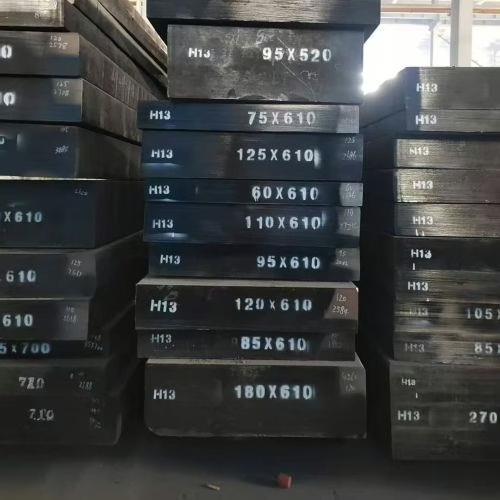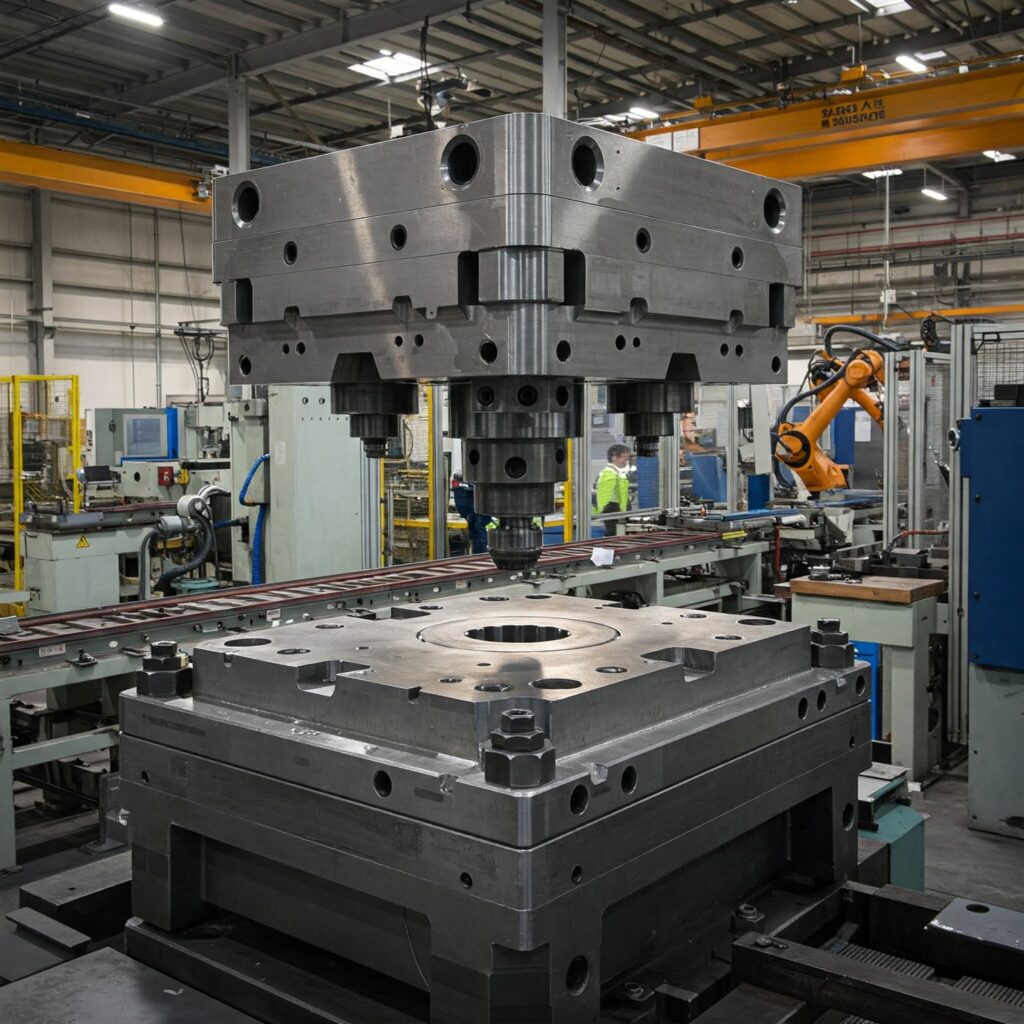Tiempo estimado de lectura: 6 minutos
Conclusiones clave
- H13 steel is a 5% chromium hot-work tool steel known for its high hardness and toughness, crucial for various applications.
- Key characteristics include good wear resistance, high tempering resistance, and the ability to maintain hardness at high temperatures.
- Hardness of H13 steel ranges from 40 to 56 HRC, with optimal values for die-casting tooling typically between 44–48 HRC.
- Factors influencing H13 hardness include chemical composition, heat treatment, and the presence of vanadium, which enhances wear resistance.
- Nitriding treatment significantly boosts surface hardness, achieving up to 1100 HV while maintaining excellent core strength.

La dureza del acero H13 es una propiedad clave en sus aplicaciones. Acero H13 Es un cromo 5% (Cr) ampliamente utilizado acero para herramientas de trabajo en calienteTambién conocido como 4Cr5MoSiV1, 1.2344, SKD61, con un contenido de carbono de aproximadamente 0,41 TP3T. Pertenece al grupo H de aceros para herramientas, que presentan resistencia al ablandamiento a altas temperaturas.
Entre sus características destacan:
- Dureza en caliente y resistencia al revenido: El H13 presenta una buena dureza al rojo y mantiene una alta dureza y resistencia a temperaturas elevadas, lo que lo hace resistente al ablandamiento térmico. Su alta resistencia al revenido le permite soportar tratamientos superficiales a alta temperatura sin una pérdida significativa de dureza del núcleo.
- Good Wear Resistance: Due to its vanadium content, H13 is very resistant to abrasion and erosive wear, especially at high temperatures.
- Dureza y resistencia al impacto: H13 posee una excelente resistencia al impacto y buena ductilidad.
- Templabilidad profunda: es un acero de endurecimiento profundo y endurecimiento por aire, lo que permite endurecer secciones grandes mediante enfriamiento por aire con tensiones residuales mínimas.
- Good Machinability: When properly annealed, H13 has a machinability rating of 70 compared to a 1% carbon steel rated at 100. Please refer to Maquinabilidad del acero para herramientas H13.
Dureza del acero para herramientas H13
En el caso del acero H13, aumentar la temperatura de temple puede aumentar la dureza revenida, pero intentar obtener una dureza excesivamente alta puede resultar en una ganancia de dureza mínima o nula, a la vez que causa una pérdida considerable de tenacidad. En la práctica, se llega a un acuerdo para las matrices: estas se templan a niveles de dureza casi máximos, a los cuales aún poseen la tenacidad suficiente para soportar la carga.
El proceso de templado es crucial para ajustar la dureza y, lo que es más importante, para aumentar la tenacidad y aliviar las tensiones internas en las herramientas endurecidas.
- Después del temple al aire, el rango de dureza del acero H13 es de 52 a 54 HRC.
- Después del temple a diferentes temperaturas, las propiedades mecánicas longitudinales de las barras de acero H13 a temperatura ambiente son las siguientes:
| Dureza (HRC) | Temperatura (°C) | Temperatura (°F) |
| 52 | 527 | 980 |
| 50 | 555 | 1030 |
| 48 | 575 | 1065 |
| 46 | 593 | 1100 |
| 44 | 605 | 1120 |
- For die-casting tooling, the optimum working hardness for H13 is typically 44–48 HRC. For tooling requiring shock resistance, it is 40–44 HRC. H13 combines good red hardness, abrasion resistance, and resistance to heat checking at hardness levels ranging from 45 to 50 HRC.
- La dureza típica del núcleo H13 después de la nitruración es de ~45 HRC, con una dureza superficial superior a 1000 HV (>70 HRC).
- En procesos de extrusión, el H13 presenta una dureza de 48-52 HRC para punzones y matrices. En la forja a martillo y la forja mecánica en prensa, las matrices H13 presentan una dureza de 47-56 HRC.
Factors Influencing H13 Hardness
Two factors influence the hardness of H13 steel: chemical composition and heat treatment process.
The hardness, strength, wear resistance, and tempering resistance of H13 primarily stem from its alloying elements, particularly vanadium (V). Compared to H11, H13 possesses a higher vanadium content, promoting the dispersion of high-hardness MC-type vanadium carbides.
At the micro level, H13’s hardness depends on two factors: the hardness of the martensitic matrix and the quantity and type of carbides distributed within it. During tempering, the co-precipitation of MC-type carbides alongside molybdenum-rich carbides (M6C) and chromium-rich carbides (M23C6) is the primary driver of the secondary hardening effect.
During the heat treatment process of H13 steel, the standard austenitizing temperature is approximately 1030°C, which determines how much carbon and alloying elements can dissolve into the austenitic matrix. The more complete the dissolution, the higher the hardness of the martensite formed after quenching. H13 exhibits a relatively flat tempering curve, yielding similar hardness values across a broad temperature range.
* Todas las muestras se enfriaron al aire desde 1025 °C (1875 °F) y se templaron durante 2 h a esa temperatura. AQ, recién templado. Consulte Tratamiento térmico del acero H13.
Hardness and Toughness of H13 Steel
There exists a significant inverse relationship between hardness and toughness. While increasing hardness enhances a mold’s resistance to wear and plastic deformation, this inevitably comes at the expense of the steel’s toughness. Experimental data indicate that as the hardness of H13 steel increases, its Charpy V-notch impact energy exhibits a decreasing trend.
Therefore, in practical engineering applications, avoid pursuing the maximum hardness of H13. Excessively high hardness leads to a sharp reduction in toughness, significantly increasing the risk of premature cracking and failure in the mold.
For applications subjected to severe impact, such as hot forging dies, it is generally recommended to control hardness at the lower end of the recommended range, e.g., 40–44 HRC, to prioritize die toughness and prevent brittle fracture.
Surface Hardness Enhancement: Nitriding H13 Steel
For applications requiring extremely high surface hardness, H13 is an excellent candidate material for nitriding treatment. The key reason H13 responds well to the nitriding process lies in its high chromium (Cr) content.
Nitriding is a thermochemical treatment process that involves diffusing nitrogen into the surface of steel, where it combines with alloying elements like chromium in the substrate to form extremely hard chromium nitride, creating a tough protective layer. Data indicates that post-nitriding H13 steel can achieve surface hardness approaching 1100 HV. This exceptional surface hardness directly translates into outstanding wear resistance, making it highly suitable for high-temperature forming processes with severe abrasion, such as hot forging and extrusion.
Beyond its exceptional surface hardness, H13’s other significant advantage during nitriding is its core stability. Many different steel grades experience significant softening in the core during the high-temperature nitriding process, resulting in insufficient support strength. H13, however, maintains excellent core hardness at nitriding temperatures, typically around 45 HRC. This combination of a high-hardness surface layer and a high-strength core enables it to withstand demanding conditions involving both severe wear and exposure to heavy impacts or extremely high unit loads. It prevents the surface-hardened layer from spalling due to matrix collapse.


